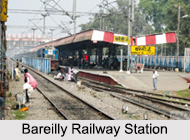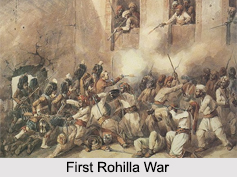 History of Bareilly is traced back from Mahabharata era. It is said that Bareilly is considered as the birthplace of Draupadi, one of the important characters in Mahabharata. It is also known as "Panchali". Later it came in the prominence of Indian history during rule of Gupta Empire. But with the advent of Muslim and British imperialism, Bareilly became the epicenter of armed revolts especially from 1770s to 1857. The folklore from the early era says that Gautama Buddha had once visited the ancient fortress of Ahichchhatra in Bareilly. Parshavnath one of the Jain Tirthankara is said to have achieved Kaivalya at Ahichchhatra.
History of Bareilly is traced back from Mahabharata era. It is said that Bareilly is considered as the birthplace of Draupadi, one of the important characters in Mahabharata. It is also known as "Panchali". Later it came in the prominence of Indian history during rule of Gupta Empire. But with the advent of Muslim and British imperialism, Bareilly became the epicenter of armed revolts especially from 1770s to 1857. The folklore from the early era says that Gautama Buddha had once visited the ancient fortress of Ahichchhatra in Bareilly. Parshavnath one of the Jain Tirthankara is said to have achieved Kaivalya at Ahichchhatra.
Early History of Bareilly
The early history of Bareilly began with the rule of Lord Krishna at Panchali. When Yudhishthira became the king of Hastinapur, Draupadi became his queen. After the era of Mahabharata, Bareilly became the center of administration during Gupta Empire. Archaeological Survey of India excavated the ruins of Ahichchhatra, which developed in 5th Century BC.
 Medieval History of Bareilly
Medieval History of Bareilly
In the 12th century, the kingdom of Panchala was under the rule by different clans of Kshatriya Rajputs. With the Islamic Turkish Invasion the region became a part of the Delhi Sultanate before getting absorbed in the emerging Mughal Empire. The foundation of the modern city of Bareilly foundation was laid by Mukrand Rai in 1657. Later the medieval era of Bareilly became the capital of Rohilkhand region before getting handed over to Nawab Vazir of Awadh and then to British East India Company later which was transferred to the British Government in India and later becoming an integral part of India.
Modern History of Bareilly
The modern history of Bareilly began with the downfall of Mughal Dynasty and the introduction of British Empire in India in the midst of various battles and revolts of the tribal people. In 1772, the Bhosles of Maratha Empire repeatedly defeated Rohillas and from that time the modern history of Bareilly began. The First Rohilla War (1772-1774) began with the attack of Shuja-ud-Daula, Nawab of Awadh, against the Rohillas, Afghan highlanders settled in Rohilkhand, northern India. The Nawabs of Awadh were later supported by mercenaries of the British East India Company and they were defeated. Rohilkhand fell to Awadh, was plundered and occupied. The majority of the Rohillas left. They fled across the Ganga River in numbers, to start a guerilla war; or emigrated. Later the Princely State of Rohillakhand was formed in Rampur. Bareilly was a major core during the Indian Rebellion of 1857. The mutiny began with the hands of Indian soldiers who were against the race based injustices and inequities. The Sepoy Mutiny was started on 10th May 1857 in the town of Meerut. In 18th Century, this place became the hot seat for the Indian National Congress from the time of Khilafat movement when Mahatma Gandhi visited this town twice and many Hindus and Muslims were arrested.



















